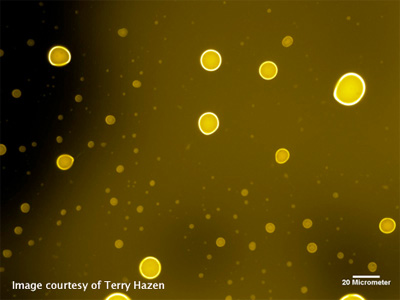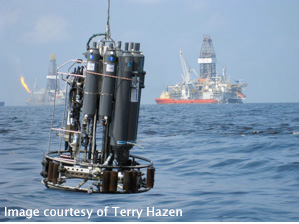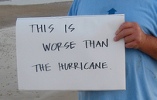BP’s disastrous oil spill in the Gulf of Mexico this year killed countless marine animals, but it was a boon for oil-eating bacteria. The organisms, usually quiescent deep in the ocean, burst into life when the Deep Water Horizon wellhead ruptured and released a torrent of their favorite food.
A study published in the 8 October issue of Science demonstrated how quickly bacteria consumed the light crude oil. The bacteria were “fat and happy,” microbial ecologist Terry Hazen of Lawrence Berkeley National Laboratory told mongabay.com. Hazen led the study’s international group of 31 researchers.
The team deployed collection canisters from ships in the gulf in May and June at 17 locations along a 30-km-long oil plume. They compared deep-water samples from inside and outside the plume. The sheer number of bacteria and the plethora of species in the plume, compared to the rest of the water, told researchers that oil was feeding the rapidly multiplying microbes. The way the oil broke down was another clue: shorter hydrocarbon chains, which microbes prefer to eat, disappeared faster.
 Bacteria feasted on microscopic oil droplets like these after the Deep Water Horizon oil spill. Image courtesy of: Terry Hazen |
Smaller amounts of oil have been spurting into the gulf for tens of millions of years, particularly around tectonic plate boundaries, said Hazen. Oil escapes naturally through fissures in the ocean floor. Every day, such seeps release about 1,400 barrels of oil into the Northern gulf alone, according to researchers at the Woods Hole Oceanographic Institution.
“Oil is a natural product. It’s a biological product,” Hazen said. “It doesn’t surprise us that organisms have adapted to using it over millions of years.”
The surprise, he noted, was how fast the bacteria ate the crude. Hazen’s team found the microbes’ consumption was significantly faster than expected for deep-water temperatures between 4 and 5◦C—but not fast enough to contain the spill. “Was this an ecological disaster? No doubt about it,” Hazen said.
BP used millions of liters of a chemical dispersant, called Corexit, to break up the oil gushing from the wellhead. The dispersant may have made it easier for bacteria to consume the oil, according to Hazen. Dispersed oil comprises much smaller particles than untreated oil, so bacteria can feed on more droplet surface area.
 Researchers deployed canister rigs from ships in the Gulf of Mexico to collect water samples from 1,100 meters (3,600 feet) below the surface. Image courtesy of: Terry Hazen |
The dispersant’s long-term effects are unknown, Hazen said. Toxicology tests run by the U.S. Environmental Protection Agency showed that it was toxic to at least one species of shrimp.
Despite the bacteria’s appetites, Hazen does not recommend adding foreign organisms to the sites of other oil spills. “Indigenous bugs are probably better adapted to their particular environment. Within 72 hours of a spill, their numbers will increase—anywhere,” he said. Hazen believes this kind of oil biodegradation could happen in any marine area with natural seeps.
David Valentine, a microbial geochemist at the University of California, Santa Barbara, has mixed feelings about the findings. “I think the microbiology was excellent,” he told mongabay.com in an email. However, he thinks the rate of bacterial oil consumption was slower than the study reported. “What they actually measured in nature was a combination of dilution and biodegradation, with dilution likely being the greater factor,” Valentine said.
Sascha Zubryd is a graduate student in the Science Communication Program at the University of California, Santa Cruz.
Related articles
Already Critically Endangered, bluefin tuna hit hard by BP oil disaster
(10/19/2010) Using satellite data from the European Space Agency, researchers estimate that over 20% of juvenile Atlantic bluefin tuna in the Gulf of Mexico were killed by the BP oil spill. Although that percentage may not seem catastrophic, the losses are on top of an 82% decline in the overall population over the past three decades due to overfishing. The population plunge has pushed the International Union for the Conservation of Nature (IUCN) to categorize the fish as Critically Endangered, its highest rating before extinction.

(07/29/2010) “President Obama called it ‘the worst environmental disaster America has ever faced.’ So I thought I should face it and head to the Gulf”—these are the opening words on the popular blog Guilty Planet as the author, marine biologist Jennifer Jacquet, embarked on a ten day trip to Louisiana. As a scientist, Jacquet was, of course, interested in the impact of the some four million barrels of oil on the Gulf’s already depleted ecosystem, however she was as equally keen to see how Louisianans were coping with the fossil fuel-disaster that devastated their most vital natural resource just four years after Hurricane Katrina.
Goodbye to the Gulf: oil disaster hits region’s ‘primary production’

(07/08/2010) According to a new analysis by the World Resources Institute (WRI), the many ecosystem services provided by the Gulf of Mexico will be severely impacted by BP’s giant oil spill. ‘Ecosystem services’ are the name given by scientists and experts to free benefits provided by intact ecosystems, for example pollination or clean water. In the Gulf of Mexico, such environmental benefits maintain marine food production, storm buffers, tourism, and carbon sequestration, but one of the most important of marine ecosystem services is known as ‘primary production’.







